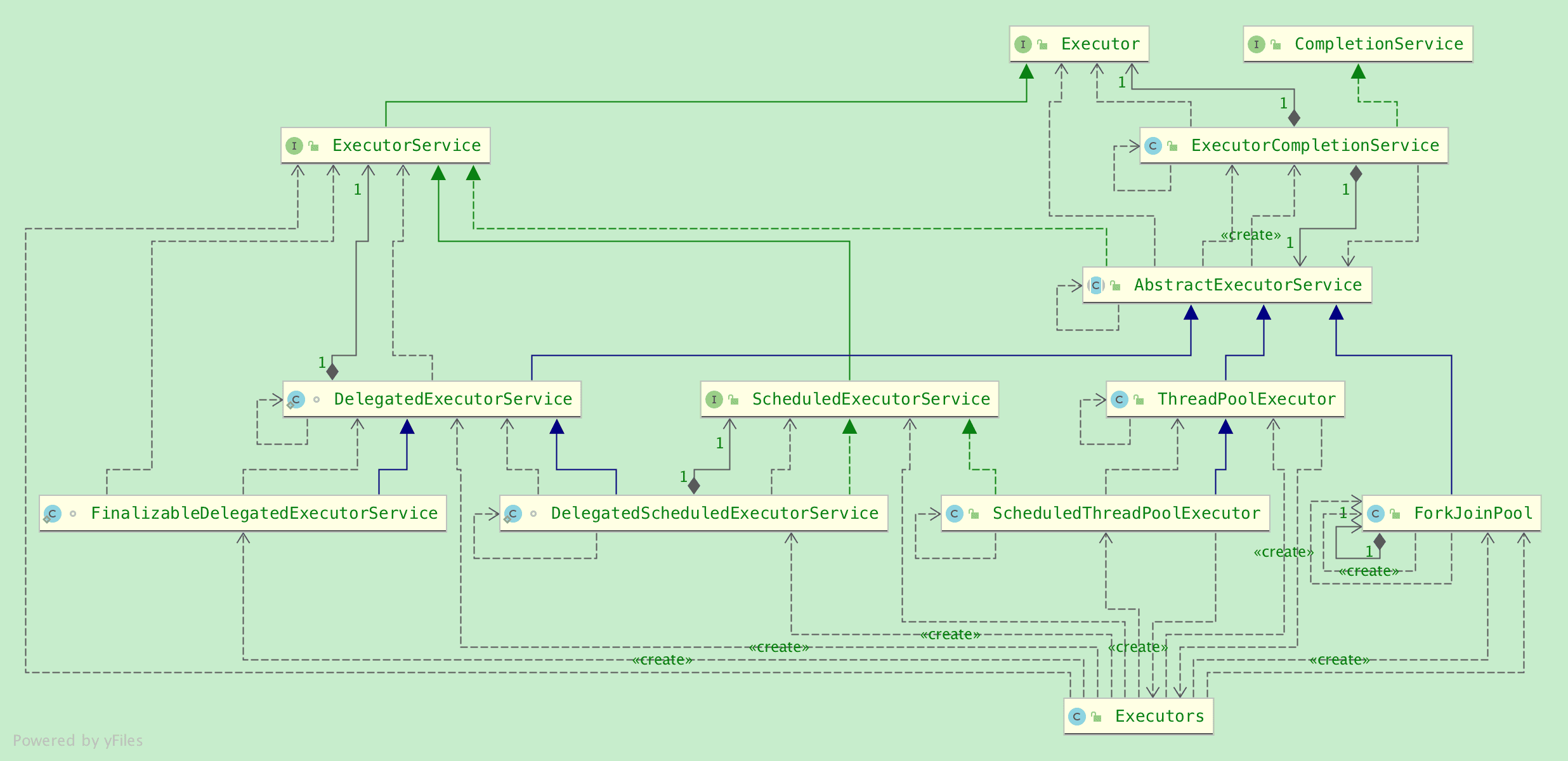Executors与Executor框架
Executors可以称作执行器。Java并发系列的文章到目前为止,虽然没有特别说明,但是使用执行器(Executor(s))的次数已经难以计数了,Executors提供了一些非常方便的静态方法,可以根据需要创建不同的ExecutorService,然后调用其execute(Runnable)或submit(Callable<T>)方法。
在并发条件下,执行器还有一个非常明显的优势,它使用线程池管理线程,减少了系统创建和销毁线程的开销。在一般的Java并发过程中,也建议使用执行器完成任务而非显式地创建线程。
本文将从执行器开始,阐述Java中的线程池。
Executors类 #
java.util.concurrent.Executors类提供了许多静态方法来获取不同类型的 线程池,下表列出其常用方法1:
| 方法 | 概要 |
|---|---|
newFixedThreadPool | 创建固定大小的线程池,线程会一直保留 |
newCachedThreadPool | 创建线程池,该线程池在必要时创建新线程,旧线程也会被重用,线程空闲60s被销毁 |
newSingleThreadExecutor | 相当于newFixedThreadPool(1),其能保证任务顺序执行 |
newScheduledThreadPool | 创建计划执行一次或周期执行的线程池 |
newSingleThreadScheduledExecutor | 创建计划执行一次或周期执行的单线程池 |
Executors用于构造线程池的部分方法
上表中的前3个方法返回ThreadPoolExecutor实例,后面2个方法返回ScheduledExecutorService实例,不管是ThreadPoolExecutor或是ScheduledExecutorService,都是ExecutorService的实现,ExecutorService接口是设计用来处理任务的接口,其顶层接口是java.util.concurrent.Executor,该接口简单地定义了一个执行任务的方法:
1public interface Executor {
2 /**
3 * Executes the given command at some time in the future. The command
4 * may execute in a new thread, in a pooled thread, or in the calling
5 * thread, at the discretion of the {@code Executor} implementation.
6 *
7 * @param command the runnable task
8 * @throws RejectedExecutionException if this task cannot be
9 * accepted for execution
10 * @throws NullPointerException if command is null
11 */
12 void execute(Runnable command);
13}
因此对执行器的讨论最终要回到对Executor及其实现上来。

Java Executor框架的主要构成
下图展示了Executor框架的执行逻辑2
flowchart LR
A(["Main Thread"]) -->|Create| B(Rannable)
A --> | Create| C("Callable<\V>")
B --> | execute| D(ExecutorServiceth)
B --> |submit| D
C --> |submit| D
D --> |return| G(Future<\V>)
A --> |get| G
A --> | cancel| H
subgraph D["EcecutorServiceth"]
E(ThreadPoolExecutor)
F(ScheduledThreadPoolExecutor)
end
subgraph G[Future<\V>]
H(FutureTask<\V>)
end
从上面的框架组成图中,可以清晰的看到使用Executors能够构建所有线程池实例,ExecutorService接口定义了一系列和线程池以及任务相关的基本方法,用于检查关闭/关闭线程池,提交任务,执行任务等。
AbstractExecutorService直接实现了ExecutorService的invokeAny/invokeAll方法。此外,从该类的源码可以清晰地看到,所有的任务都是通过转化为RunnableFuture(FutureTask)而后通过execute(Runnable)方法执行的。
1protected <T> RunnableFuture<T> newTaskFor(Callable<T> callable) {
2 return new FutureTask<T>(callable);
3}
4
5public <T> Future<T> submit(Callable<T> task) {
6 if (task == null) throw new NullPointerException();
7 RunnableFuture<T> ftask = newTaskFor(task);
8 execute(ftask);
9 return ftask;
10}
11
12protected <T> RunnableFuture<T> newTaskFor(Runnable runnable, T value) {
13 return new FutureTask<T>(runnable, value);
14}
15
16public Future<?> submit(Runnable task) {
17 if (task == null) throw new NullPointerException();
18 RunnableFuture<Void> ftask = newTaskFor(task, null);
19 execute(ftask);
20 return ftask;
21}
22
23public <T> Future<T> submit(Runnable task, T result) {
24 if (task == null) throw new NullPointerException();
25 RunnableFuture<T> ftask = newTaskFor(task, result);
26 execute(ftask);
27 return ftask;
28}
ScheduledExecutorService 接口继承自 ExecutorService,
定义了用于计划执行或周期执行的线程池方法。
ThreadPoolExecutor
继承自 AbstractExecutorService,是线程池重要的实现之一。
ScheduledThreadPoolExecutor
继承自 ScheduledExecutorService,是线程池重要的实现之二。
ForkJoinPool
继承自 AbstractExecutorService,是线程池的重要实现之三,关于它的内容将单独展开。
DelegatedExecutorService
继承自 AbstractExecutorService ,它是 Executors 的内部类,
是一个仅仅实现了 ExecutorService 方法的包装类,
其有两个子类分别是 DelegatedScheduledExecutorServide
和 FinalizableDelegatedExecutorService。
CompletionService 接口有一个子类 ExecutorCompletionService,
该类由执行器实例化,用来管理执行器执行的任务的结果。
ExecutorService接口 #
ExecutorService是次顶层接口,定义了线程池操作任务的基本方法。
// 继承自Executor的方法
void execute(Runnable command);
void shutdown();
/*有序地关闭线程池,已经提交(在运行或已经在队列中)的任务不会受到影响,将继续执行,
但线程池不接受新任务的提交
此法不会在当前线程上等待线程池后台任务的执行结果(或者任务执行后的作用),换言之,
如果想要获取任务执行之后的结果,调用此法无法达到目的*/
List<Runnable> shutdownNow();
/*尝试去停止(stop)所有活动的任务,已提交且队列中的中的任务将取消执行,并返回取消的任务队列。
向正在执行的任务发送中断命令,那些无法响应中断命令的任务将无法中止
和shutdown()方法一样,此法不会等待正在执行的任务终止*/
boolean isShutdown();
// 如果线程池已经关闭,返回true
boolean isTerminated();
/*如果所有的任务都完成(中止运行或正常运行完成),则返回true
注意,若没有先调用shutdown()或shutdownNow(),此方法不可能返回true*/
boolean awaitTermination(long timeout, TimeUnit unit) throws InterruptedException;
/*线程池shutdown请求之后,阻塞当前线程,等待任务执行。当超时,任务执行完毕,或当前线程被中断
任一情况发生时,终止阻塞*/
<T> Future<T> submit(Callable<T> task);
// 提交一个有返回结果的Callable任务
<T> Future<T> submit(Runnable task, T result);
// 提交一个Runnable并指定其返回result
Future<?> submit(Runnable task);
/*提交一个Runnable,返回的Future<?>的get方法将返回null,其主要目的是利用Future的其他
方法控制任务的执行*/
<T> List<Future<T>> invokeAll(Collection<? extends Callable<T>> tasks)
throws InterruptedException;
/*执行集合中包含的任务,并返回一个Future<T>集合,Future<T>集合包含各个任务的执行状态及结果
Future<T>集合中的的顺序和任务集合中的迭代顺序是一致的
这个方法会等待所有的任务执行完成(正常执行或抛出异常),如果任务集合在执行过程中被修改,那么
任务的结果将会变为undefined*/
<T> List<Future<T>> invokeAll(Collection<? extends Callable<T>> tasks,
long timeout, TimeUnit unit)
throws InterruptedException;
/* 执行集合中包含的任务,在所有任务执行完成或超时之前返回一个Future<T>集合。在返回之前,
未能执行的任务将被取消
其他的特征和重载方法一致*/
<T> T invokeAny(Collection<? extends Callable<T>> tasks)
throws InterruptedException, ExecutionException;
/* 执行给定的任务集合中的任务,返回任何一个成功执行的任务的结果,其他未完成的任务被取消
如果任务集合在执行过程中被修改,那么任务的结果将会变为undefined*/
<T> T invokeAny(Collection<? extends Callable<T>> tasks,
long timeout, TimeUnit unit)
throws InterruptedException, ExecutionException, TimeoutException;
/* 执行给定的任务集合中的任务,在超时之前返回任何一个成功执行的任务的结果,
其他未完成的任务被取消
如果任务集合在执行过程中被修改,那么任务的结果将会变为undefined*/
如上所示,ExecutorService定义了线程池的基本方法,其中invokeAny和invokeAll方法在AbstractExecutorService中实现。